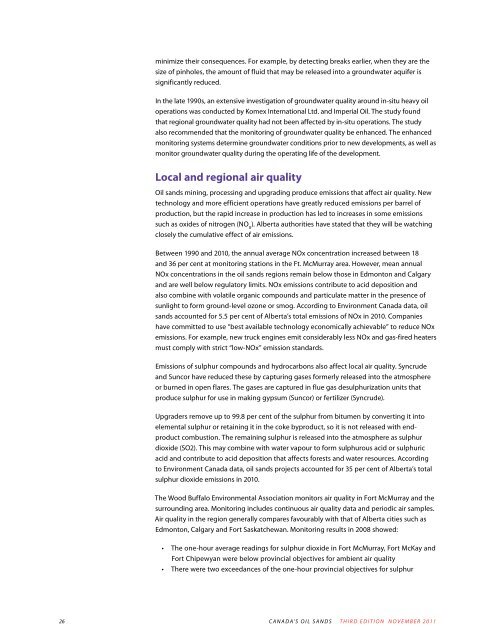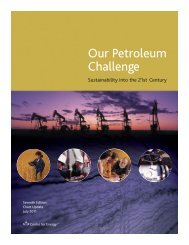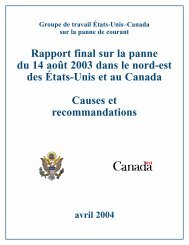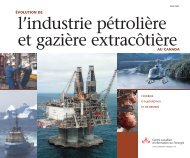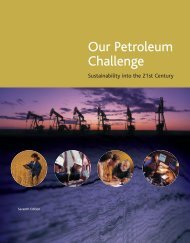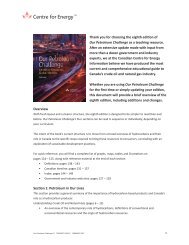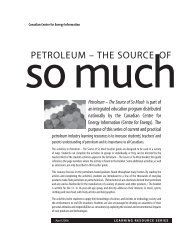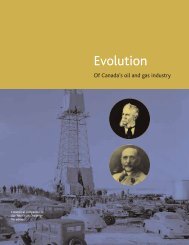Canada's Oil Sands - Centre for Energy
Canada's Oil Sands - Centre for Energy
Canada's Oil Sands - Centre for Energy
Create successful ePaper yourself
Turn your PDF publications into a flip-book with our unique Google optimized e-Paper software.
minimize their consequences. For example, by detecting breaks earlier, when they are the<br />
size of pinholes, the amount of fluid that may be released into a groundwater aquifer is<br />
significantly reduced.<br />
In the late 1990s, an extensive investigation of groundwater quality around in-situ heavy oil<br />
operations was conducted by Komex International Ltd. and Imperial <strong>Oil</strong>. The study found<br />
that regional groundwater quality had not been affected by in-situ operations. The study<br />
also recommended that the monitoring of groundwater quality be enhanced. The enhanced<br />
monitoring systems determine groundwater conditions prior to new developments, as well as<br />
monitor groundwater quality during the operating life of the development.<br />
Local and regional air quality<br />
<strong>Oil</strong> sands mining, processing and upgrading produce emissions that affect air quality. New<br />
technology and more efficient operations have greatly reduced emissions per barrel of<br />
production, but the rapid increase in production has led to increases in some emissions<br />
such as oxides of nitrogen (NO x<br />
). Alberta authorities have stated that they will be watching<br />
closely the cumulative effect of air emissions.<br />
Between 1990 and 2010, the annual average NOx concentration increased between 18<br />
and 36 per cent at monitoring stations in the Ft. McMurray area. However, mean annual<br />
NOx concentrations in the oil sands regions remain below those in Edmonton and Calgary<br />
and are well below regulatory limits. NOx emissions contribute to acid deposition and<br />
also combine with volatile organic compounds and particulate matter in the presence of<br />
sunlight to <strong>for</strong>m ground-level ozone or smog. According to Environment Canada data, oil<br />
sands accounted <strong>for</strong> 5.5 per cent of Alberta’s total emissions of NOx in 2010. Companies<br />
have committed to use “best available technology economically achievable” to reduce NOx<br />
emissions. For example, new truck engines emit considerably less NOx and gas-fired heaters<br />
must comply with strict “low-NOx” emission standards.<br />
Emissions of sulphur compounds and hydrocarbons also affect local air quality. Syncrude<br />
and Suncor have reduced these by capturing gases <strong>for</strong>merly released into the atmosphere<br />
or burned in open flares. The gases are captured in flue gas desulphurization units that<br />
produce sulphur <strong>for</strong> use in making gypsum (Suncor) or fertilizer (Syncrude).<br />
Upgraders remove up to 99.8 per cent of the sulphur from bitumen by converting it into<br />
elemental sulphur or retaining it in the coke byproduct, so it is not released with endproduct<br />
combustion. The remaining sulphur is released into the atmosphere as sulphur<br />
dioxide (SO2). This may combine with water vapour to <strong>for</strong>m sulphurous acid or sulphuric<br />
acid and contribute to acid deposition that affects <strong>for</strong>ests and water resources. According<br />
to Environment Canada data, oil sands projects accounted <strong>for</strong> 35 per cent of Alberta’s total<br />
sulphur dioxide emissions in 2010.<br />
The Wood Buffalo Environmental Association monitors air quality in Fort McMurray and the<br />
surrounding area. Monitoring includes continuous air quality data and periodic air samples.<br />
Air quality in the region generally compares favourably with that of Alberta cities such as<br />
Edmonton, Calgary and Fort Saskatchewan. Monitoring results in 2008 showed:<br />
• The one-hour average readings <strong>for</strong> sulphur dioxide in Fort McMurray, Fort McKay and<br />
Fort Chipewyan were below provincial objectives <strong>for</strong> ambient air quality<br />
• There were two exceedances of the one-hour provincial objectives <strong>for</strong> sulphur<br />
26 CANADA’S OIL SANDS THIRD edition November 2011


